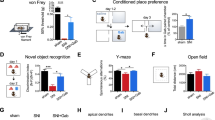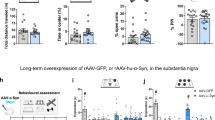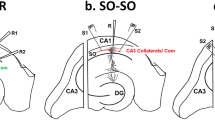Abstract
Patients with chronic pain usually suffer from working memory deficits, which may decrease their intellectual ability significantly. Despite intensive clinical studies, the mechanism underlying this form of memory impairment remains elusive. In this study, we investigated this issue in the spared nerve injury (SNI) model of neuropathic pain, a most common form of chronic pain. We found that SNI impaired working memory and short-term memory in rats and mice. To explore the potential mechanisms, we studied synaptic transmission/plasticity in hippocampus, a brain region critically involved in memory function. We found that frequency facilitation, a presynaptic form of short-term plasticity, and long-term potentiation at CA3–CA1 synapses were impaired after SNI. Structurally, density of presynaptic boutons in hippocampal CA1 synapses was reduced significantly. At the molecular level, we found that tumor necrosis factor-α (TNF-α) increased in cerebrospinal fluid, in hippocampal tissue and in plasma after SNI. Intracerebroventricular or intrahippocampal injection of recombinant rat TNF mimicked the effects of SNI in naive rats, whereas inhibition of TNF-α or genetic deletion of TNF receptor 1 prevented both memory deficits and synaptic dysfunction induced by SNI. As TNF-α is critical for development of neuropathic pain, we suggested that the over-production of TNF-α following peripheral nerve injury might lead to neuropathic pain and memory deficits, simultaneously.
Similar content being viewed by others
Log in or create a free account to read this content
Gain free access to this article, as well as selected content from this journal and more on nature.com
or
References
Alloway TP, Gathercole SE, Kirkwood H, Elliott J (2009). The cognitive and behavioral characteristics of children with low working memory. Child Dev 80: 606–621.
Audette JF, Emenike E, Meleger AL (2005). Neuropathic low back pain. Curr Pain Headache Rep 9: 168–177.
Awh E, Vogel EK, Oh SH (2006). Interactions between attention and working memory. Neuroscience 139: 201–208.
Bruel-Jungerman E, Davis S, Laroche S (2007). Brain plasticity mechanisms and memory: a party of four. Neuroscientist 13: 492–505.
Butler MP, O’Connor JJ, Moynagh PN (2004). Dissection of tumor-necrosis factor-alpha inhibition of long-term potentiation (LTP) reveals a p38 mitogen-activated protein kinase-dependent mechanism which maps to early-but not late-phase LTP. Neuroscience 124: 319–326.
Cao L, DeLeo JA (2008). CNS-infiltrating CD4+ T lymphocytes contribute to murine spinal nerve transection-induced neuropathic pain. Eur J Immunol 38: 448–458.
Cao L, Palmer CD, Malon JT, De Leo JA (2009). Critical role of microglial CD40 in the maintenance of mechanical hypersensitivity in a murine model of neuropathic pain. Eur J Immunol 39: 3562–3569.
Chaplan SR, Bach FW, Pogrel JW, Chung JM, Yaksh TL (1994). Quantitative assessment of tactile allodynia in the rat paw. J Neurosci Methods 53: 55–63.
Cunningham AJ, Murray CA, O’Neill LA, Lynch MA, O’Connor JJ (1996). Interleukin-1 beta (IL-1 beta) and tumour necrosis factor (TNF) inhibit long-term potentiation in the rat dentate gyrus in vitro. Neurosci Lett 203: 17–20.
Decosterd I, Woolf CJ (2000). Spared nerve injury: an animal model of persistent peripheral neuropathic pain. Pain 87: 149–158.
Dick BD, Rashiq S (2007). Disruption of attention and working memory traces in individuals with chronic pain. Anesth Analg 104: 1223–1229.
Eccleston C (1995). Chronic pain and distraction: an experimental investigation into the role of sustained and shifting attention in the processing of chronic persistent pain. Behav Res Therapy 33: 391–405.
Etherton JL, Bianchini KJ, Ciota MA, Heinly MT, Greve KW (2006). Pain, malingering and the WAIS-III working memory index. Spine J 6: 61–71.
George A, Buehl A, Sommer C (2004). Wallerian degeneration after crush injury of rat sciatic nerve increases endo- and epineurial tumor necrosis factor-alpha protein. Neurosci Lett 372: 215–219.
George A, Marziniak M, Schafers M, Toyka KV, Sommer C (2000). Thalidomide treatment in chronic constrictive neuropathy decreases endoneurial tumor necrosis factor-alpha, increases interleukin-10 and has long-term effects on spinal cord dorsal horn met-enkephalin. Pain 88: 267–275.
Gould E, Leuner B (2010). Structural plasticity and hippocampal function. Annu Rev Psychol 67: 111–140.
Hart RP, Martelli MF, Zasler ND (2000). Chronic pain and neuropsychological functioning. Neuropsychol Rev 10: 131–149.
Hu Y, Yang J, Hu Y, Wang Y, Li W (2010). Amitriptyline rather than lornoxicam ameliorates neuropathic pain-induced deficits in abilities of spatial learning and memory. Eur J Anaesthesiol 27: 162–168.
Ignatowski TA, Covey WC, Knight PR, Severin CM, Nickola TJ, Spengler RN (1999). Brain-derived TNFalpha mediates neuropathic pain. Brain Res 841: 70–77.
International Association for the Study of Pain (1986). Classification of chronic pain. Descriptions of chronic pain syndromes and definitions of pain terms. Pain 3: 1–225.
Kesner RP (2007). Behavioral functions of the CA3 subregion of the hippocampus. Learn Mem 14: 771–781.
Legrain V, Damme SV, Eccleston C, Davis KD, Seminowicz DA, Crombez G (2009). A neurocognitive model of attention to pain: behavioral and neuroimaging evidence. Pain 144: 230–232.
Leite-Almeida H, Almeida-Torres L, Mesquita AR, Pertovaara A, Sousa N, Cerqueira JJ et al (2009). The impact of age on emotional and cognitive behaviours triggered by experimental neuropathy in rats. Pain 144: 57–65.
Leuner B, Shors TJ (2004). New spines, new memories. Mol Neurobiol 29: 117–130.
Leung LW (1979). Orthodromic activation of hippocampal CA1 region of the rat. Brain Res 176: 49–63.
Maletic V, Raison CL (2009). Neurobiology of depression, fibromyalgia and neuropathic pain. Front Biosci 14: 5291–5338.
Noguchi K, Obata K, Dai Y (2004). Changes in DRG neurons and spinal excitability in neuropathy. Novartis Found Symp 261: 103–110.
Offenbaecher M, Ackenheil M (2005). Current trends in neuropathic pain treatments with special reference to fibromyalgia. CNS Spectr 10: 285–297.
Pickering M, Cumiskey D, O’Connor JJ (2005). Actions of TNF-alpha on glutamatergic synaptic transmission in the central nervous system. Exp Physiol 90: 663–670.
Pickering M, O’Connor JJ (2007). Pro-inflammatory cytokines and their effects in the dentate gyrus. Prog Brain Res 163: 339–354.
Ribeiro RA, Vale ML, Ferreira SH, Cunha FQ (2000). Analgesic effect of thalidomide on inflammatory pain. Eur J Pharmacol 391: 97–103.
Rothman SM, Huang Z, Lee KE, Weisshaar CL, Winkelstein BA (2009). Cytokine mRNA expression in painful radiculopathy. J Pain 10: 90–99.
Schafers M, Brinkhoff J, Neukirchen S, Marziniak M, Sommer C (2001). Combined epineurial therapy with neutralizing antibodies to tumor necrosis factor-alpha and interleukin-1 receptor has an additive effect in reducing neuropathic pain in mice. Neurosci Lett 310: 113–116.
Sekiguchi M, Sekiguchi Y, Konno SI, Kobayashi H, Homma Y, Kikuchi SI (2009). Comparison of neuropathic pain and neuronal apoptosis following nerve root or spinal nerve compression. Eur Spine J 18: 1978–1985.
Shamash S, Reichert F, Rotshenker S (2002). The cytokine network of Wallerian degeneration: tumor necrosis factor-alpha, interleukin-1alpha, and interleukin-1beta. J Neurosci 22: 3052–3060.
Sommer C, Lindenlaub T, Teuteberg P, Schafers M, Hartung T, Toyka KV (2001). Anti-TNF-neutralizing antibodies reduce pain-related behavior in two different mouse models of painful mononeuropathy. Brain Res 913: 86–89.
Spengler RN, Sud R, Knight PR, Ignatowski TA (2007). Antinociception mediated by alpha(2)-adrenergic activation involves increasing tumor necrosis factor alpha (TNFalpha) expression and restoring TNFalpha and alpha(2)-adrenergic inhibition of norepinephrine release. Neuropharmacology 52: 576–589.
Sun HY, Lyons SA, Dobrunz LE (2005). Mechanisms of target-cell specific short-term plasticity at Schaffer collateral synapses onto interneurones vs pyramidal cells in juvenile rats. J Physiol 568: 815–840.
Tancredi V, D’Arcangelo G, Grassi F, Tarroni P, Palmieri G, Santoni A et al (1992). Tumor necrosis factor alters synaptic transmission in rat hippocampal slices. Neurosci Lett 146: 176–178.
Tobinick E (2009). Perispinal etanercept for neuroinflammatory disorders. Drug Discov Today 14: 168–177.
Toth C, Lander J, Wiebe S (2009). The prevalence and impact of chronic pain with neuropathic pain symptoms in the general population. Pain Med 10: 918–929.
Vago DR, Kesner RP (2008). Disruption of the direct perforant path input to the CA1 subregion of the dorsal hippocampus interferes with spatial working memory and novelty detection. Behav Brain Res 189: 273–283.
Wang H, Moser M, Schiltenwolf M, Buchner M (2008a). Circulating cytokine levels compared to pain in patients with fibromyalgia—a prospective longitudinal study over 6 months. J Rheumatol 35: 1366–1370.
Wang H, Schiltenwolf M, Buchner M (2008b). The role of TNF-alpha in patients with chronic low back pain-a prospective comparative longitudinal study. Clin J Pain 24: 273–278.
Wang Q, Wu J, Rowan MJ, Anwyl R (2005). Beta-amyloid inhibition of long-term potentiation is mediated via tumor necrosis factor. Eur J Neurosci 22: 2827–2832.
Wei XH, Zang Y, Wu CY, Xu JT, Xin WJ, Liu XG (2007). Peri-sciatic administration of recombinant rat TNF-alpha induces mechanical allodynia via upregulation of TNF-alpha in dorsal root ganglia and in spinal dorsal horn: the role of NF-kappa B pathway. Exp Neurol 205: 471–484.
Xu JT, Xin WJ, Zang Y, Wu CY, Liu XG (2006). The role of tumor necrosis factor-alpha in the neuropathic pain induced by lumbar 5 ventral root transection in rat. Pain 123: 306–321.
Xu L, Anwyl R, Rowan MJ (1997). Behavioural stress facilitates the induction of long-term depression in the hippocampus. Nature 387: 497–500.
Yamanaka H, Obata K, Fukuoka T, Dai Y, Kobayashi K, Tokunaga A et al (2004). Tissue plasminogen activator in primary afferents induces dorsal horn excitability and pain response after peripheral nerve injury. Eur J Neurosci 19: 93–102.
Zhang J, Shi XQ, Echeverry S, Mogil JS, De Koninck Y, Rivest S (2007). Expression of CCR2 in both resident and bone marrow-derived microglia plays a critical role in neuropathic pain. J Neurosci 27: 12396–12406.
Zou LB, Yamada K, Tanaka T, Kameyama T, Nabeshima T (1998). Nitric oxide synthase inhibitors impair reference memory formation in a radial arm maze task in rats. Neuropharmacology 37: 323–330.
Acknowledgements
We thank William D Willis Jr for editing the English of the manuscript. This work was supported by grants from the National Natural Science Foundation of China (no: 30770705) to XGL and (30630026) to GL, the Ministry of education of China (20060558001) to XGL, and National Basic Research Program of China (2009CB941303) to GL.
Author information
Authors and Affiliations
Corresponding authors
Ethics declarations
Competing interests
The authors declare no conflict of interest.
Additional information
Supplementary Information accompanies the paper on the Neuropsychopharmacology website
Rights and permissions
About this article
Cite this article
Ren, WJ., Liu, Y., Zhou, LJ. et al. Peripheral Nerve Injury Leads to Working Memory Deficits and Dysfunction of the Hippocampus by Upregulation of TNF-α in Rodents. Neuropsychopharmacol 36, 979–992 (2011). https://doi.org/10.1038/npp.2010.236
Received:
Revised:
Accepted:
Published:
Issue date:
DOI: https://doi.org/10.1038/npp.2010.236
Keywords
This article is cited by
-
Neuroinflammation in the anterior cingulate cortex: the potential supraspinal mechanism underlying the mirror-image pain following motor fiber injury
Journal of Neuroinflammation (2022)
-
2-Pentadecyl-2-oxazoline ameliorates memory impairment and depression-like behaviour in neuropathic mice: possible role of adrenergic alpha2- and H3 histamine autoreceptors
Molecular Brain (2021)
-
Nerve injury alters restraint-induced activation of the basolateral amygdala in male rats
Brain Structure and Function (2021)
-
Chronic nanocurcumin treatment ameliorates pain-related behavior, improves spatial memory, and reduces hippocampal levels of IL-1β and TNFα in the chronic constriction injury model of neuropathic pain
Psychopharmacology (2021)
-
Chronic Oral Administration of Magnesium-L-Threonate Prevents Oxaliplatin-Induced Memory and Emotional Deficits by Normalization of TNF-α/NF-κB Signaling in Rats
Neuroscience Bulletin (2021)



